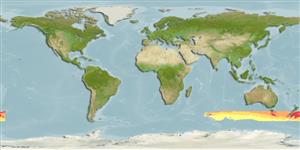Common names from other countries
分类 / Names
俗名 | 同种异名 | Catalog of Fishes(属, 种) | ITIS | CoL | WoRMS | Cloffa
Teleostei >
Zeiformes (Dories) >
Oreosomatidae (Oreos) > Oreosomatinae
Etymology: Allocyttus: Greek, allos = other + Greek, kyttaros, kytos = a convex cavity; niger: niger refers to the blackish color of freshly caught specimens. It also reflects the common name "black oreo", which has been widely used in the New Zealand deepwater fishery for several years (Ref. 27159).
Environment: milieu / climate zone / depth range / distribution range
生态学
海洋 深海区的; 海洋洄游的 (Ref. 51243); 深度上下限 560 - 1300 m (Ref. 6390). 深水域; 43°S - 55°S, 65°E - 174°W (Ref. 27159)
Southwest Pacific: New Zealand and Australian waters south of 43°S, and south of Tasmania at 47°S. Also Ref. 26139.
西南太平洋: 居住於紐西蘭與 43個 °S 澳洲水域南方。 (參考文獻 27159) 也參考文獻 26139.
Length at first maturity / 大小 / 重量 / 年龄
Maturity: Lm ?, range 36 - ? cm
Max length : 47.0 cm TL 雄鱼/尚未辨别雌雄; (Ref. 6390); common length : 35.0 cm TL 雄鱼/尚未辨别雌雄; (Ref. 9258); 最大体重: 1.5 kg (Ref. 6390); 最大年龄: 100 年 (Ref. 27140)
Found close to the sea bed in deep water. Form large shoals over rough ground near pinnacles and canyons. Juveniles are pelagic and inhabit oceanic waters. They tend to be dispersed over smooth grounds (Ref. 6390). Feed mainly on salps and benthic crustaceans (Ref. 27150). Eggs float near the sea surface and larvae also inhabit surface waters (Ref. 6390). Based on trawl catch rates, there is no evidence of vertical migration during day or night (Ref. 27150).
发现在深水中接近海床。 形成大群鱼群在峰顶与峡谷附近的粗糙的底部之上。 稚鱼是大洋性的而且居住于大洋性水域。 他们倾向零零散散的在平滑的地面之上.(参考文献 6390) 主要捕食被囊动物与底栖的甲壳动物。 (参考文献 27150) 在海洋表面与仔鱼附近的卵漂流物也居住于水表面。 (参考文献 6390) 以拖网捕捉率为依据, 没有对于垂直性回游的证据在白天或夜晚.(参考文献 27150)
Displays seasonally synchronised reproduction.西南太平洋: 居住於紐西蘭與 43個 °S 澳洲水域南方。 (參考文獻 27159) 也參考文獻 26139.
James, G.D., T. Inada and I. Nakamura, 1988. Revision of the oreosomatid fishes (Family Oreosomatidae) from the southern oceans, with a description of a new species. N.Z. J. Zool. 15:291-326. (Ref. 27159)
CITES (Ref. 128078)
Not Evaluated
人类利用
渔业: 商业性
工具
特别资料
下载 XML
网络资源
Estimates based on models
Preferred temperature (Ref.
115969): 2.1 - 6.8, mean 5.1 (based on 63 cells).
Phylogenetic diversity index (Ref.
82804): PD
50 = 0.5635 [Uniqueness, from 0.5 = low to 2.0 = high].
Bayesian length-weight: a=0.01413 (0.00715 - 0.02792), b=3.03 (2.85 - 3.21), in cm Total Length, based on LWR estimates for this species & (Sub)family-body (Ref.
93245).
营养阶层 (Ref.
69278): 3.5 ±0.50 se; based on food items.
回复力 (Ref.
120179): 非常低的, 最小族群倍增时间超过14 年 (tmax=100; tm=27; Fec >5,000).
Fishing Vulnerability (Ref.
59153): High to very high vulnerability (69 of 100).
Climate Vulnerability (Ref.
125649): Moderate vulnerability (40 of 100).
